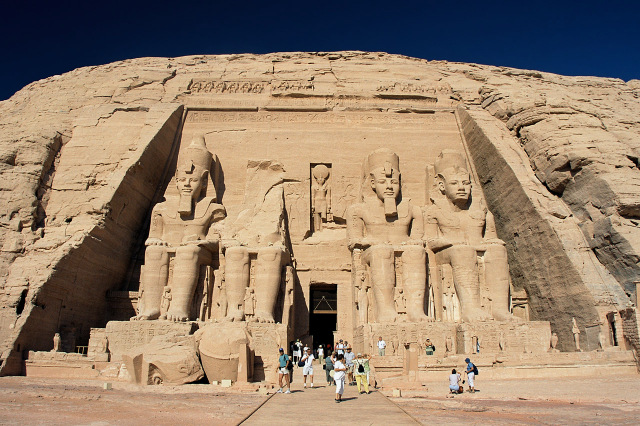In the previous article, we saw that the distinct evidences
from both the Bible and the Qur’an point firmly to an identification of the
Pharaoh of the Exodus with Ramesses II.
One element that is distinctive to the Qur’an’s narrative of
Pharaoh is that it describes him several times as “Pharaoh of the Awtād":
The people of Noah and ʿĀd, and
Pharaoh of the awtād rejected [the
messengers] before them. And Thamūd, and the people of Lot…” (38:12-13)
Have you not considered how your
Lord dealt with ʿĀd;
the city of Iram of the lofty pillars, the like of which had never been created
in the lands; Thamūd who cut the rocks in the valley; and Pharaoh of the awtād…? (89:6-10)
Muslim commentators differed over the meaning of awtād (singular watad) in this epithet, since the word is capable of a variety of
meanings.
The most common interpretation is “stakes,” on which Pharaoh
crucified people. However Fatoohi and
Al-Dargazelli argue that awtād is
used in the Qur’an not to mean “stakes” or “pegs,” but tall structures.[1] This is the interpretation of “Pharaoh of the
Awtād” that al-Qurṭubī
relates from Ibn ‘Abbās and ad-Daḥḥāk, in his commentary of
38:12:
Ibn ‘Abbās said, “It means the
owner of sturdy construction.” ad-Daḥḥāk
said, “He owned many buildings.
Buildings are called awtād.”
This makes the most sense in light of 89:6-10, quoted above,
because the other nations mentioned are also identified with the construction
of lofty, firm buildings.
There is no more appropriate description for Rameses
II. Of all the pharaohs of Egypt, he is
the one most famous for his ambitious building projects. Peter A. Clayton writes:
His genuine building achievements are on a Herculean scale. He
added to the great temples at Karnak and Luxor, completed his father Seti’s
mortuary temple at Gourna (Thebes) and also his Abydos temple, and built his
own temple nearby at Abydos. On the west bank at Thebes he constructed a giant
mortuary temple, the Ramesseum. Inscriptions in the sandstone quarries at Gebel
el-Silsila record at least 3000 workmen employed there cutting stone for the
Ramesseum alone. Other major mortuary temples rose in Nubia at Beit el-Wali,
Gerf Hussein, Wadi es-Sebua, Derr and even as far south as Napata.[2]
Similarly, Kitchen states:
certainly in his building-works for the gods the entire length of Egypt
and Nubia, Ramesses II surpassed not only the Eighteenth Dynasty but every
other period in Egyptian history. In that realm, he certainly fulfilled the
dynasty’s aims to satiety.[3]
E.P. Uphill states,
Per Ramesses was probably the
vastest and most costly royal residence ever erected by the hand of man. As can
now be seen its known palace and official centre covered an area of at least
four square miles, and its temples were in scale with this, a colossal
assemblage forming perhaps the largest collection of chapels built in the
pre-classical world by a single ruler at one time.[4]
The unique feature about Per
Ramesses is that it is the only city of imperial size in the ancient near east,
rivalling Heliopolis, Memphis and Thebes in splendour, known to have been
entirely planned, built and fully completed under one King.[5]
However, most of what Ramesses II built failed to last. The city of Pi-Ramesses was abandoned in c. 1130 BCE, after which it was dismantled. The building materials were used to build the city of Tanis, which now lies in ruins, just as the Qur'an says:
We destroyed what Pharaoh and his people used to build and what they used to erect. (7:137)Fatoohi and Al-Dargazelli also add the following observation:
The fact that the expression ‘Pharaoh
of the awtād’ occurs [in sūra 89] where Thamud’s practice of
building houses in mountains is mentioned may suggest that this title also
implicitly refers to the two temples at Abu Simbel in Nubia which were cut in the
living rock of the mountainside. The first of these, the ‘Great Temple,’ is a
huge building with two pairs of colossal seated figures of Ramesses II, each 18
meter high, flanking its entrance. These temples are considered to be Ramesses
II's greatest building achievement.[6]
The Great Temple of Abu Simbel. For more on the temples of Abu Simbel, see “The Identification Of Pharaoh During The Time Of Moses.”
Islamic-Awareness.org, 4 Jan. 2012.
Against this historical background, one can truly appreciate
the following āya:
Pharaoh was most surely lofty in
the land and most surely he was of the extravagant (musrifīn). (10:83)
[1] See Fatoohi and Al-Dargazelli, 107-111.
[2] Clayton, P. A. (1994). Chronicle of the Pharaohs: The Reign ‑By‑Reign Record
of the Rulers and Dynasties of Ancient Egypt, Thames & Hudson: Slovenia.
Cited in Fatoohi and Al-Dargazelli, 110.
Emphasis added.
[3] Kitchen, K. A. (1982). Pharaoh Triumphant: The Life and Times of Ramesses II King of Egypt,
Aris & Phillips ltd: Warminster.
Cited in Fatoohi and Al-Dargazelli, 110.
Emphasis added.
[4] E. P. Uphill, “Pithom And Raamses: Their Location And
Significance,” Journal Of Near Eastern
Studies, 1968, Volume 27, Number 4, p. 299.
Qtd. in “The Identification Of Pharaoh During The Time Of Moses.”
Islamic-Awareness.org, 4 Jan. 2012.
Accessed 12 Feb. 2015.
[5] E. P. Uphill, The Temples Of Per Ramesses, 1984, Aris
& Phillips, Warminster: England, p. 228.
Qtd. in “The Identification of Pharaoh.”

Does the biblical account identify the pharoah to be interested in building?
ReplyDeleteedit: nevermind, its in your second sentence ha.